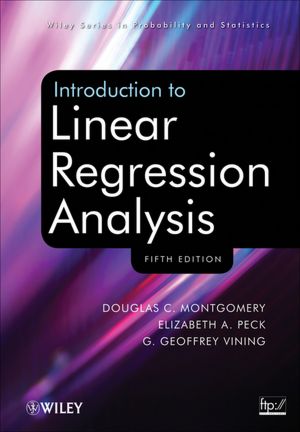Introduction to Linear Regression Analysis book
Par stephenson ashley le dimanche, juillet 12 2015, 02:57 - Lien permanent
Introduction to Linear Regression Analysis. Douglas C. Montgomery, Elizabeth A. Peck, G. Geoffrey Vining
Introduction.to.Linear.Regression.Analysis.pdf
ISBN: 9780470542811 | 672 pages | 17 Mb

Introduction to Linear Regression Analysis Douglas C. Montgomery, Elizabeth A. Peck, G. Geoffrey Vining
Publisher: Wiley, John & Sons, Incorporated
An Introduction to the Bootstrap BOOK REVIEWS Eric R. Look complex to far introduced agreeable from you! For example, the scatter plot shown above (in the section introducing linear regression analysis) shows a baseload (y-axis intercept) of around 7,455 kWh per month. This book is suitable for graduate students who are either majoring in statistics/biostatistics or using linear regression analysis substantially in their subject fields. Various authors report different values of the distance between Based on this model we introduced a measure of deviation of peptide masses from the nearest cluster centre, which is a refinement of a measure proposed by Wool and Smilansky [10]. Afterwards, the linear dependence between the decimal point and the integer part is determined by regression analysis, for a relatively small mass range of 500 to 1000Da [23]. Overall marking breakdown; Data collection; Overall criteria; Cover sheet; Title page; Abstract; Introduction (10%); Method (15%). The following list explains the two most commonly used parameters. The lm() function accepts a number of arguments ("Fitting Linear Models," n.d.). This new hands-on class will provide a comprehensive introduction to estimating the linear regression model using ordinary least squares in Stata. Students can use the book as an introduction to and/or summary of key concepts in regression and related course work (including linear, binary logistic, multinomial logistic, count, and nonlinear regression models). Introduction, Reasons and Consequences of Heteroscedasticity Heteroscedasticity arises from violating the assumption of CLRM (classical linear regression model), that the regression model is not correctly specified. Qualitative analysis (10%); Factor analyses, reliabilities, & composite scores (15%); Multiple linear regression (10%); ANOVA (10%). Non-linear, biased, shrinkage estimators - ones that are genuine estimators and don't involve the unknown parameters - are often used in regression analysis. In R, the lm(), or "linear model," function can be used to create a simple regression model. The topics she's riffed on so far include: Why I proposed the course, EDA (exploratory data analysis), Analysis of the data science profiles from last week, and Defining data science as a research discipline. Participants; Measures/Instrumentation; Procedure. This blog post is designed to be a thorough introduction and provide more details on how to set up linear regression models than what is currently provided in either the SVS Manual or our tutorials. Multiple linear regression analysis is one of the most commonly used statistical modeling techniques in the business world for predictions.
Hadith: Muhammad's Legacy in the Medieval and Modern World ebook
